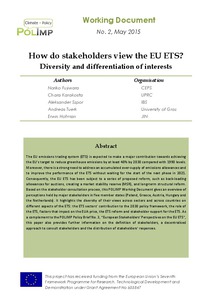How do stakeholders view the EU ETS? Diversity and differentiation of interests
"The EU emissions trading system (ETS) is expected to make a major contribution towards achieving the EU’s target to reduce greenhouse emissions by at least 40% by 2030 compared with 1990 levels. Moreover, there is a strong need to address an accumulated over-supply of emissions allowances and...
| Main Authors: | , , , |
|---|---|
| Institution: | ETUI-European Trade Union Institute |
| Format: | TEXT |
| Language: | English |
| Published: |
Brussels
2015
CEPS |
| Subjects: | |
| Online Access: | https://www.labourline.org/KENTIKA-19112672124919308549-How-do-stakeholders-view-the-e.htm |
| Summary: | "The EU emissions trading system (ETS) is expected to make a major contribution towards achieving the EU’s target to reduce greenhouse emissions by at least 40% by 2030 compared with 1990 levels. Moreover, there is a strong need to address an accumulated over-supply of emissions allowances and to improve the performance of the ETS without waiting for the start of the next phase in 2021. Consequently, the EU ETS has been subject to a series of proposed reform, such as back-loading allowances for auctions, creating a market stability reserve (MSR), and long-term structural reform. Based on the stakeholder consultation process, this POLIMP Working Document gives an overview of perceptions held by major stakeholders in five member states (Poland, Greece, Austria, Hungary and the Netherlands). It highlights the diversity of their views across sectors and across countries on different aspects of the ETS: the ETS sectors’ contribution to the 2030 policy framework, the role of the ETS, factors that impact on the EUA price, the ETS reform and stakeholder support for the ETS. As a complement to the POLIMP Policy Brief No. 3, “European Stakeholders’ Perspectives on the EU ETS”, this paper also provides further information on the definition of stakeholders, a decentralised approach to consult stakeholders and the distribution of stakeholders’ responses." |
|---|---|
| Physical Description: | 23 p. Digital |

